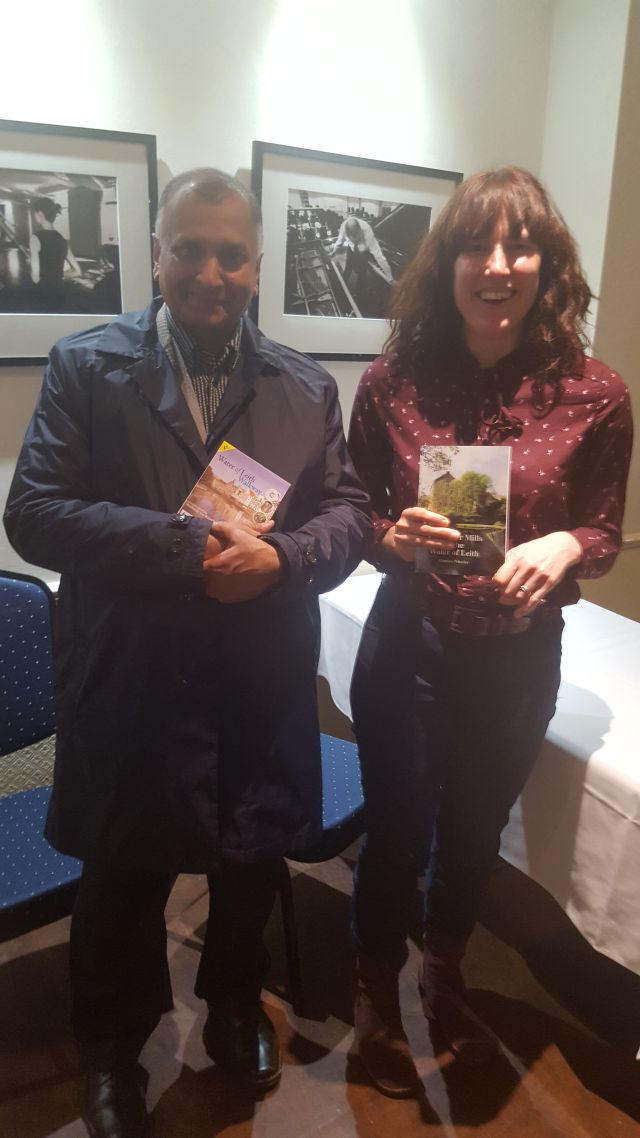Flowing out of Harperrig Reservoir, the Water of Leith passes through the peaty moorland that gives its distinctive brown colour to hit the city boundary at Balerno. Former industrial communities are encountered at Currie and Juniper Green before it reaches Colinton Dell, the only stretch to enjoy protection as an area of biodiversity interest. At Slateford are the Water of Leith Conservation Trust, an aqueduct and viaduct, then it reaches Gorgie Road at Chesser and Saughton Park where its function becomes clearest as an urban wildlife corridor. Murrayfield contains the only remaining section of natural floodplain which is now being tackled in the second phase of the flood prevention works, then it resumes running in a gorge through Belford and the Dean Village to reach Stockbridge below which was the first phase of the flood prevention works protecting Warriston, St Mark’s Park and Bonnington, and thereafter it opens out into the Port of Leith.

Neville Singh with Charlotte Neary
The Water of Leith Walkway stretching twelve miles from Balerno to the Victoria Bridge at Leith is a great walking and cycling route because there are so many opportunities to join or leave it perhaps in search of nearby places of refreshment. 76 working watermills once lined the river’s banks until the last one closed in the 1970s. The largest weir is the World’s End above Dean Village. Modern waterwheels have been installed in traditional locations at Bonnyhaugh and Redford Mill. There are restored millstones at the Dean Village, and three grottoes were provided by landowners to give shelter and interesting architecture. St Bernard’s Well is a sulphur spring graced by a classical temple with a pumproom lined by mosaics with goldplated stars which was in daily use until in the 1950s the water was deemed not fit for human consumption, and still functions on special occasions. The Dean Bridge is at 90 feet the tallest crossing of the river, built in 1832 by Thomas Telford for Sir John Learmonth to connect his properties, and had to have parapets added to stop people from jumping. Leith Harbour was tidal until the addition of lock gates which reduced the number of salmon but act as a silt trap. The haunt of dippers and herons, Bell’s Weir is a rural delight just twenty minutes’ walk from the West End.
93 species of aquatic plant with their roots in water such as avens, cuckoo-spit and rushes can be found along the river, with Scottish hyacinths, foxgloves and campion in the adjoining woodland helping make up the over 200 native species that can be found in just one mile. Wildflower meadows maintained by cutting and raking can be seen at Bell’s and Bog’s Mills. Non-native species that require management to counter their invasiveness are Himalayan balsam that can be controlled but not eliminated, Japanese knotweed which must be removed if it is not to damage buildings, and giant hogweed which must also be taken out since contact with human skin can cause allergic reactions. It is quicker to spray rather than inject giant hogweed, but there is an environmental risk so other solutions being investigated include electrocution. Other non-native species that are tolerated because they are not invasive include Spanish hyacinth, leopard’s bane, honesty and American currant. Fish include the brown trout which is all now native (free permits available to anglers between April and September), lamprey which attach themselves to other fish, bullhead which is the main introduced species but enjoys European protection, pike that have come in from the Union Canal and salmon which together with mayflies are a good indicator of water quality. Herons come from a heronry in Duddingston Loch to visit all parts of the river, and the dipper has perfectly evolved to enjoy the riverbank environment. The kingfisher, territorial and solitary, is perfectly camouflaged, appearing like a leaf from below and merging with the sky. Swans, coots, moorhen, mallards and small woodland species such as nuthatches complete the list of birds, while mammals include the fox, badger, roe deer and otter, represented by one female with cubs and a visiting male and often confused with mink.